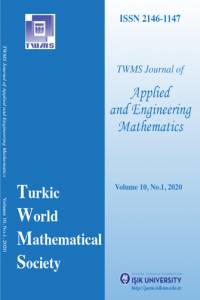ESTIMATING RETURNS TO SCALE USING NON-RADIAL DEA MODELS
Radial and non-radial model, Returns To Scale RTS .,
___
- Allahyar M., Rostamy-Malkhalifeh M. (2015). “An improved approach for estimating returns to scale in DEA”. Bull Malays Math Sci Soc. 37(4), 1185-1194.
- Banker R.D., Charnes A., Cooper W. W. (1984). “Some models for estimating technical and scale efficiencies in date envelopment analysis”. Manage Sci. 30, 1078-1092.
- Banker R.D. (1984). “ Estimating most productive scale size using data envelopment analysis”. Eur J Oper Res. 17, 35-44.
- Banker R.D., Cooper W.W., Thrall R.M., Seiford L.M., Zhu J. (2004). “Returns to scale in different
- DEA models”. Eur J Oper Res. 154, 345-362. Banker R.D., Thrall R.M. (1992). “Estimation of returns to scale using date envelopment analysis”. Eur J Oper Res. 62, 74-84.
- Charnes A., Cooper W.W., Rhodes E. (1978). “Measuring the efficiency of decision making units”. Eur J Oper Res. 2, 429-444.
- Cooper W.W., Park K.S., Pastor J.T. (2000). “RAM: A range adjusted measure of efficiency”. J Prod Anal. 11, 5-42.
- Forsund F.R. (1996). “On the calculation of scale elasticities in DEA models”. J Prod Anal. 7, 283-302
- Forsund F.R., Hjalmarsson L., Krivonozhko V.E., Utkin O.B. (2007). “Calculation of scale elasticities in DEA models: Direct and indirect approaches”. J Prod Anal. 28, 45-56.
- Golany B., Yu G. (1997). “Estimating returns to scale in DEA”. Eur J Oper Res. 103, 28-37.
- Hadjicostas P., Soteriou A.C. (2006). “One-sided elasticities and technical efficiency in multi-output production: A theoretical framework”. Eur J Oper Res. 198, 425-449.
- Jahanshahloo G.R., Soleimani-damaneh M., Rostamy-Malkhalifeh M. (2005). “An enhanced procedure for estimating returns-to-scale in DEA”. Appl Math Comput. 171, 1226-1238.
- Podinovski V.V., Fosund F.R. (2010). “Differential characteristics of efficient frontiers in data envel- opment analysis”. Oper Res. 58, 1743-1754.
- Podinovski V.V., Forsund F.R., Krivonozhko V.E. (2009). “A simple derivation of scale elasticity in data envelopment analysis”. Eur J Oper Res. 197, 149-153.
- Soleimani-Damaneh M. (2012). “On a basic definition of returns to scale”. Oper Res Lett. 40, 144-147.
- Soleimani-damaneh M., Jahanshahloo G.R., Reshadi M. (2006). “On the estimation of returns to scale in FDH models”. Eur J Oper Res. 174(2), 1055-1059.
- Tone K. (2001). “On returns to scale under weights restrictions in data envelopment analysis”. J Prod Anal. 16, 31-47.
- Krivonozhko V.E., Forsund F.R., Lychev A.V. (2014). “Measurement of returns to scale using non- radial DEA models”. Eur J Oper Res. 232, 664-670.
- Zarepisheh M., Soleimani-damaneh M. (2009). “A dual simplex-based method for determination of the right and left returns to scale in DEA”. Eur J Oper Res. 194, 585-591.
- Zarepisheh M., Soleimani-damaneh M., Pourkarimi L. (2006). “Determination of returns to scale by CCR formulation without chasing down alternative optimal solutions”. Appl Math Lett. 19(9), 964-967.
- Zelenyuk V. (2013). “A scale elasticity measure for directional distance function and its dual: Theory and DEA estimation”. Eur J Oper Res. 228, 592-600. Ta
- ISSN: 2146-1147
- Başlangıç: 2010
- Yayıncı: Turkic World Mathematical Society
F. MECHİGHEL, N. ARMOUR, S. DOST
N. SREEDHAR, K. R. PRASAD, S. BALAKRİSHNA
